

A simple fur pike fly
Necessary items:
- Tying vice (I use an imitation of a Regal Vice)
- Bobbin holder
- Tying thread (I use Uni Big Fly)
- Pike fly hook, I use size 1/0 or 3/0 (you can use smaller ones for perch)
- Head cement
- A small pair of sharp scissors
- Fur strips in different colors
Info:
Flyfishing with a pike fly can be done with barbless hooks. If you prefer to fish with these hooks, you can easily use a regular hook and to crush the barb with a pair of pliers. Try this before you tie the pike fly because some hooks are of inferior quality and the when you crush the barb sometimes the hookpoint will break. It's very annoying to find that out when you have tied the fly because your work will be useless then. I haven't invented this fly but I copied it after a good example I have.
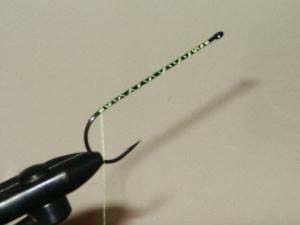
Step-by-step instructions:
Put the hook in the vice. Attach the tying thread and start at about 2/3 of the hookbend. Wrap the tying thread towards the hook eye and back to the point where you started. (see picture 1)
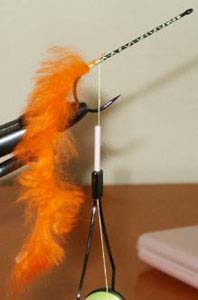
Smear a thin coat of head cement on the wrappings and allow it to dry for a while.
Take a fur strip of about 1 or 1.5 times the length of the hook shank. Remove the hairs over a length of 1cm. This is the piece that will be tied on the hook shank. Use a pair of scissors to cut a small point on the end of this 1cm piece. Position this point where you started tying the thread and fix it in place with a few wrappings of thread. Tighten these wrappings by pulling them tight with the bobbin holder, but make sure it doesn't move! Use about 10 more wrappings to secure this piece of fur. (see picture 2)
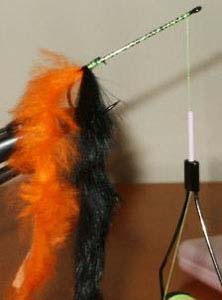
Take a new strip of fur, and again remove 1cm of the hairs on one side. Again cut a small point on this end of the fur? Repeat the process of securing ths piece of 1cm to the hook shank. Make sure you tighten this piece of fur so that the hair lies in the direction of the hook eye. So 180° opposed to the tail. Again finish these wrappings of with head cement and allow it to dry. (see picture 3)
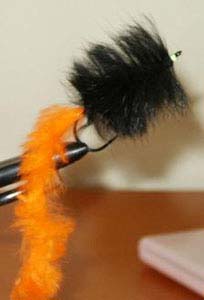
Smear head cement on the hook shank so the fur will stick to it when you wrap it around the hook shank towards the hook eye. This really makes your fly a lot more durable. Turn the furstrip tightly around the hook shank towards the hook eye. Make sure each turn is positioned nex to the previous one. If they are put over one another, less hair will flare and then your pike fly will have less action in the water. When you reach the hook eye, secure the fur strip in place with about 20 wrappings and cut off the remainder of the strip with a pair of scissors. Use the xwrappings to form a nice small head. Use 3-5 whip finish knots and coat the "head" with two coats of head cement. This fly is now ready for use! (see picture 4)
When your pike fly is wet and out of the water, it looks like a drowned angora rabbit, but in the water the fur flares open when you pause and closes when you pull the fly. THis creates quite of abit of disturbence in the water.
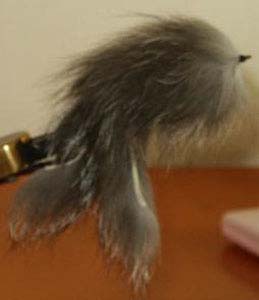
Some variations:
- You can first weight the fly by wrapping some lead around the hook shank (this lead is just like a thick thread) before you secure the second fur strip in place. Or you can add two eyes from a bead-chain from the sink or bathtub.
- You can use artic fox hair as well instead of fur (or finnish fur fly) to make a huge pike fly. (see picture 5)
- You can vary the colors. For instance you can add a short piece of red fur to act as a head, a white fur strip to act as a body and a blue fur strip to act as a tail.
- Try adding two tails instead of one for a twistertail action.






